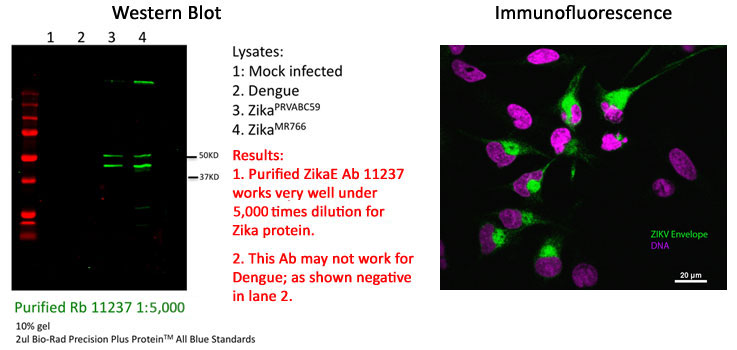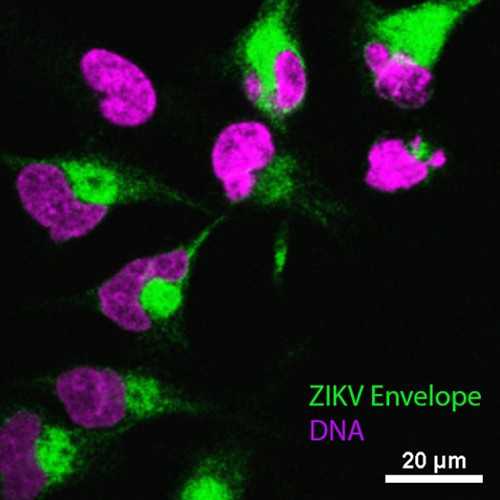Anti-Zika Virus Envelope (E) Protein Antibody
This rabbit polyclonal antibody was generated against a polypeptide corresponding to the envelope (E) protein of Zika virus and recognizes ZIKV E protein.
Highlights:
- Reacts with Zika Virus E protein
- Suitable for Western Blot and Immunofluorescence applications
Zika virus (ZIKV) is a member of the virus family Flaviviridae and the genus Flavivirus, transmitted by daytime-active Aedes mosquitoes. Zika is related to other mosquito transmitted viruses such as dengue, yellow fever, Japanese encephalitis and west nile. Similar to other flaviviruses, ZIKV is enveloped and icosahedral and has a nonsegmented, single-stranded, positive-sense RNA genome. Common symptoms of infection with the virus include mild headaches, maculopapular rash, fever, malaise, conjunctivitis, and joint pains. Zika has been shown to cause microcephaly in babies exposed in utero.
From the laboratory of Timothy L. Megraw, PhD, Florida State University.
This rabbit polyclonal antibody was generated against a polypeptide corresponding to the envelope (E) protein of Zika virus and recognizes ZIKV E protein.
Highlights:
- Reacts with Zika Virus E protein
- Suitable for Western Blot and Immunofluorescence applications
Zika virus (ZIKV) is a member of the virus family Flaviviridae and the genus Flavivirus, transmitted by daytime-active Aedes mosquitoes. Zika is related to other mosquito transmitted viruses such as dengue, yellow fever, Japanese encephalitis and west nile. Similar to other flaviviruses, ZIKV is enveloped and icosahedral and has a nonsegmented, single-stranded, positive-sense RNA genome. Common symptoms of infection with the virus include mild headaches, maculopapular rash, fever, malaise, conjunctivitis, and joint pains. Zika has been shown to cause microcephaly in babies exposed in utero.
From the laboratory of Timothy L. Megraw, PhD, Florida State University.
| Product Type: | Antibody |
| Antigen: | Zika Envelope |
| Accession ID: | A0A142I5B9, KU501215 |
| Molecular Weight: | about 27 kDa |
| Clonality: | Polyclonal |
| Reactivity: | Zika virus |
| Immunogen: | Polypeptide |
| Species Immunized: | Rabbit |
| Purification Method: | Protein A/G |
| Method Used to Determine Concentration: | A280 |
| Buffer: | PBS, 50% glycerol |
| Tested Applications: | WB: 1:5,000; IF: 1:1000 |
| Concentration: | 0.5mg/mL |
| Comments: | Protein sequence from strain MR766; on a western blot, Zika envelope protein runs as two bands of approximately 50 kDa (see figure) due to glycosylation. |
| Storage: | -20C |
| Shipped: | Cold packs |

- Lingel A, Lin H, Gavriel Y, Weaver E, Polepole P, Lopez V, Lei Y, Petro TM, Solomon B, Zhang C, Zhang L. Amyloid precursor protein is a restriction factor that protects against Zika virus infection in mammalian brains. J Biol Chem. 2020 Oct 7:jbc.RA120.015165. View article
If you publish research with this product, please let us know so we can cite your paper.


